Solid Angle Geometry-Based Modeling of Volume Scattering with Application in the Adaptive Decomposition of GF-3 Data of Sea Ice in Antarctica
Abstract
1. Introduction
2. Coherent Scattering Modeling for a 3D Oriented Ellipsoidal Particle
2.1. Scattering Matrix for a 3D Oriented Ellipsoidal Particle
2.2. Coherency Matrix for a 3D Oriented Spheroidal Particle
3. PDFs Modeling for 3D Uniformly Oriented Ellipsoidal Particles
3.1. Solid Angle
3.2. PDFs
4. Volume Scattering Modeling for 3D Uniformly Distributed Spheroidal Particles
4.1. Multiplicative Volume Scattering Model
4.2. Special Scenerios
4.3. Simulation
- (1)
- Sign of is related to the shape and orientation of particles but independent of incidence .
- (2)
- Entropy is influenced by particle shape and orientation; of prolates is higher than that of oblates.
- (3)
- The scattering angle is also determined by particle shape and orientation; of prolates is higher than that of oblates. of prolates with vertical orientation is higher than that of prolates with horizontal orientation. Moreover, of oblates is more easily affected by the incidence . The - variation becomes more significant as the mean tilt angle increases.
5. Adaptive Polarimetric Decomposition of Volume Scattering Component for Sea Ice
5.1. Scattering Models for Decomposition
- (1)
- (2)
- (3)
- The brine inclusions are approximated by dipoles, as the size of brine inclusions in sea ice is usually at millimeter or even submillimeter level, smaller than the working wavelength of the existing spaceborne PolSAR systems [65,66,67]. As a result, , i.e., , and is typically 1, without loss of generality.
5.2. Decomposition Method
5.3. Transmission Effect
6. Decomposition Experiment on GF-3 PolSAR Data of Antarctica
6.1. Dataset in Prydz Bay
6.2. Results and Analysis
6.3. Discussion
- (1)
- Take the extinction effects into the developed volume models and decomposition to achieve an estimation of the thickness of sea ice.
- (2)
- Retrieve the surface and double-bounce scattering components after the volume decomposition to distinguish different types of sea ice.
7. Conclusions
Author Contributions
Funding
Data Availability Statement
Conflicts of Interest
Appendix A
References
- Cheung, H.H.; Keenlyside, N.; Omrani, N.-E.; Zhou, W. Remarkable link between projected uncertainties of Arctic sea-ice decline and winter Eurasian climate. Adv. Atmos. Sci. 2018, 35, 38–51. [Google Scholar] [CrossRef]
- Wu, H.; Bai, S.; Li, H.; Zhang, Z.; Wang, Z.; Wang, K.; Liu, Q. Modeling and forecasting of Bohai Sea ice. J. Cold. Reg. Eng. 2000, 14, 68–80. [Google Scholar] [CrossRef]
- Sun, S.; Su, J.; Shi, P. Features of sea ice disaster in the Bohai Sea in 2010. J. Nat. Disasters 2011, 20, 87–93. [Google Scholar]
- Mallory, M.L.; Gilchrist, H.G.; Janssen, M.; Major, H.L.; Merkel, F.; Provencher, J.F.; Strøm, H. Financial costs of conducting science in the Arctic: Examples from seabird research. Arct. Sci. 2018, 4, 624–633. [Google Scholar] [CrossRef]
- Zibordi, G.; Van Woert, M.L. Antarctic sea ice mapping using the AVHRR. Remote Sens. Environ. 1993, 45, 155–163. [Google Scholar] [CrossRef]
- Parkinson, C.L.; Comiso, J.C. Antarctic sea ice parameters from AMSR-E data using two techniques and comparisons with sea ice from SSM/I. J. Geophys. Res. Oceans 2008, 113, C02S06. [Google Scholar] [CrossRef]
- Cavalieri, D.J. A microwave technique for mapping thin sea ice. J. Geophys. Res. Oceans 1994, 99, 12561–12572. [Google Scholar] [CrossRef]
- Swan, A.M.; Long, D.G. Multiyear Arctic sea ice classification using QuikSCAT. IEEE Trans. Geosci. Remote Sens. 2012, 50, 3317–3326. [Google Scholar] [CrossRef]
- Lindell, D.B.; Long, D.G. Multiyear Arctic sea ice classification using OSCAT and QuikSCAT. IEEE Trans. Geosci. Remote Sens. 2015, 54, 167–175. [Google Scholar] [CrossRef]
- Tonboe, R.; Toudal, L. Classification of new-ice in the Greenland Sea using Satellite SSM/I radiometer and SeaWinds scatterometer data and comparison with ice model. Remote Sens. Environ. 2005, 97, 277–287. [Google Scholar] [CrossRef]
- Lindell, D.B.; Long, D.G. Multiyear Arctic ice classification using ASCAT and SSMIS. Remote Sens. 2016, 8, 294. [Google Scholar] [CrossRef]
- Wakabayashi, H.; Mori, Y.; Nakamura, K. Sea ice detection in the sea of Okhotsk using PALSAR and MODIS data. IEEE J. Sel. Top. Appl. Earth Obs. Remote Sens. 2013, 6, 1516–1523. [Google Scholar] [CrossRef]
- Li, J.; Wang, C.; Wang, S.; Zhang, H.; Fu, Q.; Wang, Y. Gaofen-3 sea ice detection based on deep learning. In Proceedings of the Progress in Electromagnetics Research Symposium-Fall, Singapore, 19–22 November 2017; pp. 933–939. [Google Scholar]
- Zhang, T.; Yang, Y.; Shokr, M.; Mi, C.; Li, X.-M.; Cheng, X.; Hui, F. Deep learning based sea ice classification with Gaofen-3 fully polarimetric SAR data. Remote Sens. 2021, 13, 1452. [Google Scholar] [CrossRef]
- Huynen, J.R. Phenomenological Theory of Radar Targets. Ph.D. Dissertation, Delft University of Technology, Delft, The Netherlands, 1970. [Google Scholar]
- Holm, W.A.; Barnes, R.M. On radar polarization mixed target state decomposition techniques. In Proceedings of the IEEE National Radar Conference, Ann Arbor, MI, USA, 20–21 April 1988; pp. 249–254. [Google Scholar]
- Yang, J.; Peng, Y.-N.; Yamaguchi, Y.; Yamada, H. On Huynen’s decomposition of a Kennaugh matrix. IEEE Geosci. Remote Sens. Lett. 2006, 3, 369–372. [Google Scholar] [CrossRef]
- Li, D.; Zhang, Y. Unified Huynen phenomenological decomposition of radar targets and its classification applications. IEEE Trans. Geosci. Remote Sens. 2015, 54, 723–743. [Google Scholar] [CrossRef]
- Cloude, S.R. Uniqueness of target decomposition theorems in radar polarimetry. In Direct and Inverse Methods in Radar Polarimetry; Boerner, W.-M., Cram, L.A., Holm, W.A., Stein, D.E., Wiesbeck, W., Keydel, W., Giuli, D., Gjessing, D.T., Molinet, F.A., Brand, H., Eds.; Kluwer: Dordrecht, The Netherlands, 1992; pp. 267–296. [Google Scholar]
- Cloude, S.R.; Pottier, E. An entropy based classification scheme for land applications of polarimetric SAR. IEEE Trans. Geosci. Remote Sens. 1997, 35, 68–78. [Google Scholar] [CrossRef]
- Touzi, R. Target scattering decomposition in terms of roll-invariant target parameters. IEEE Trans. Geosci. Remote Sens. 2006, 45, 73–84. [Google Scholar] [CrossRef]
- Freeman, A.; Durden, S.L. A three-component scattering model for polarimetric SAR data. IEEE Trans. Geosci. Remote Sens. 1998, 36, 963–973. [Google Scholar] [CrossRef]
- Yamaguchi, Y.; Moriyama, T.; Ishido, M.; Yamada, H. Four-component scattering model for polarimetric SAR image decomposition. IEEE Trans. Geosci. Remote Sens. 2005, 43, 1699–1706. [Google Scholar] [CrossRef]
- Freeman, A. Fitting a two-component scattering model to polarimetric SAR data from forests. IEEE Trans. Geosci. Remote Sens. 2007, 45, 2583–2592. [Google Scholar] [CrossRef]
- Zhang, L.; Zou, B.; Cai, H.; Zhang, Y. Multiple-component scattering model for polarimetric SAR image decomposition. IEEE Geosci. Remote Sens. Lett. 2008, 5, 603–607. [Google Scholar] [CrossRef]
- An, W.; Cui, Y.; Yang, J. Three-component model-based decomposition for polarimetric SAR data. IEEE Trans. Geosci. Remote Sens. 2010, 48, 2732–2739. [Google Scholar]
- Arii, M.; Van Zyl, J.J.; Kim, Y. Adaptive model-based decomposition of polarimetric SAR covariance matrices. IEEE Trans. Geosci. Remote Sens. 2010, 49, 1104–1113. [Google Scholar] [CrossRef]
- Van Zyl, J.J.; Arii, M.; Kim, Y. Model-based decomposition of polarimetric SAR covariance matrices constrained for nonnegative eigenvalues. IEEE Trans. Geosci. Remote Sens. 2011, 49, 3452–3459. [Google Scholar] [CrossRef]
- Shan, Z.; Wang, C.; Zhang, H.; An, W. Improved four-component model-based target decomposition for polarimetric SAR data. IEEE Geosci. Remote Sens. Lett. 2011, 9, 75–79. [Google Scholar] [CrossRef]
- Singh, G.; Yamaguchi, Y.; Park, S.-E. General four-component scattering power decomposition with unitary transformation of coherency matrix. IEEE Trans. Geosci. Remote Sens. 2012, 51, 3014–3022. [Google Scholar] [CrossRef]
- Cui, Y.; Yamaguchi, Y.; Yang, J.; Kobayashi, H.; Park, S.-E.; Singh, G. On complete model-based decomposition of polarimetric SAR coherency matrix data. IEEE Trans. Geosci. Remote Sens. 2013, 52, 1991–2001. [Google Scholar] [CrossRef]
- Chen, S.-W.; Wang, X.-S.; Xiao, S.-P.; Sato, M. General polarimetric model-based decomposition for coherency matrix. IEEE Trans. Geosci. Remote Sens. 2013, 52, 1843–1855. [Google Scholar] [CrossRef]
- Liu, G.-F.; Li, M.; Wang, Y.-J.; Zhang, P. A novel freeman decomposition based on nonnegative eigenvalue decomposition with non-reflection symmetry. J. Electron. Inf. Technol. 2013, 35, 368–375. [Google Scholar] [CrossRef]
- Wang, C.; Yu, W.; Wang, R.; Deng, Y.; Zhao, F. Comparison of nonnegative eigenvalue decompositions with and without reflection symmetry assumptions. IEEE Trans. Geosci. Remote Sens. 2013, 52, 2278–2287. [Google Scholar] [CrossRef]
- Lee, J.-S.; Ainsworth, T.L.; Wang, Y. Generalized polarimetric model-based decompositions using incoherent scattering models. IEEE Trans. Geosci. Remote Sens. 2013, 52, 2474–2491. [Google Scholar] [CrossRef]
- An, W.; Xie, C. An improvement on the complete model-based decomposition of polarimetric SAR data. IEEE Geosci. Remote Sens. Lett. 2014, 11, 1926–1930. [Google Scholar]
- Xie, Q.; Ballester-Berman, J.D.; Lopez-Sanchez, J.M.; Zhu, J.; Wang, C. Quantitative analysis of polarimetric model-based decomposition methods. Remote Sens. 2016, 8, 977. [Google Scholar] [CrossRef]
- Singh, G.; Malik, R.; Mohanty, S.; Rathore, V.S.; Yamada, K.; Umemura, M.; Yamaguchi, Y. Seven-component scattering power decomposition of POLSAR coherency matrix. IEEE Trans. Geosci. Remote Sens. 2019, 57, 8371–8382. [Google Scholar] [CrossRef]
- Li, D.; Zhang, Y.; Liang, L. A mathematical extension to the general four-component scattering power decomposition with unitary transformation of coherency matrix. IEEE Trans. Geosci. Remote Sens. 2020, 58, 7772–7789. [Google Scholar] [CrossRef]
- Sharma, J.J.; Hajnsek, I.; Papathanassiou, K.P.; Moreira, A. Polarimetric decomposition over glacier ice using long-wavelength airborne PolSAR. IEEE Trans. Geosci. Remote Sens. 2010, 49, 519–535. [Google Scholar] [CrossRef]
- Moen, M.-A.N.; Ferro-Famil, L.; Doulgeris, A.P.; Anfinsen, S.N.; Gerland, S.; Eltoft, T. Polarimetric decomposition analysis of Sea Ice data. In Proceedings of the International Workshop on Science and Applications of SAR Polarimetry and Polarimetric Interferometry, Frascati, Italy, 26–30 January 2013. [Google Scholar]
- Xi, Z.; Jie, Z.; Junmin, M.; Tengfei, S.; Meijie, L. Polarimetric scattering characteristics based sea ice types classification by polarimetric synthetic aperture radar: Taking sea ice in the Bohai Sea for example. Acta Ceanologica Sin. 2013, 35, 95–101. (In Chinese) [Google Scholar]
- Eltoft, T.; Doulgeris, A.P.; Grahn, J. Model-based polarimetric decomposition of Arctic sea ice. In Proceedings of the European Conference on Synthetic Aperture Radar, Berlin, Germany, 2–6 June 2014; pp. 1–4. [Google Scholar]
- Hossain, M.; Yackel, J.; Dabboor, M.; Fuller, M.C. Application of a three-component scattering model over snow-covered first-year sea ice using polarimetric C-band SAR data. Int. J. Remote Sens. 2014, 35, 1786–1803. [Google Scholar] [CrossRef]
- Zhang, X.; Dierking, W.; Zhang, J.; Meng, J. A polarimetric decomposition method for ice in the Bohai Sea using C-band PolSAR data. IEEE J. Sel. Top. Appl. Earth Obs. Remote Sens. 2014, 8, 47–66. [Google Scholar] [CrossRef]
- Parrella, G.; Hajnsek, I.; Papathanassiou, K.P. Polarimetric decomposition of L-band PolSAR backscattering over the Austfonna ice cap. IEEE Trans. Geosci. Remote Sens. 2015, 54, 1267–1281. [Google Scholar] [CrossRef]
- Shokr, M.; Dabboor, M. Observations of SAR polarimetric parameters of lake and fast sea ice during the early growth phase. Remote Sens. Environ. 2020, 247, 111910. [Google Scholar] [CrossRef]
- Parrella, G.; Hajnsek, I.; Papathanassiou, K.P. Retrieval of Firn Thickness by Means of Polarisation Phase Differences in L-Band SAR Data. Remote Sens. 2021, 13, 4448. [Google Scholar] [CrossRef]
- Parrella, G.; Hajnsek, I.; Papathanassiou, K.P. Model-based interpretation of PolSAR data for the characterization of glacier zones in Greenland. IEEE J. Sel. Top. Appl. Earth Obs. Remote Sens. 2021, 14, 11593–11607. [Google Scholar] [CrossRef]
- Shokr, M.; Dabboor, M.; Lacelle, M.; Zagon, T.; Deschamps, B. Observations from C-Band SAR Fully Polarimetric Parameters of Mobile Sea Ice Based on Radar Scattering Mechanisms to Support Operational Sea Ice Monitoring. CAN J. Remote Sens. 2022, 48, 197–213. [Google Scholar] [CrossRef]
- He, L.; He, X.; Hui, F.; Ye, Y.; Zhang, T.; Cheng, X. Investigation of polarimetric decomposition for Arctic summer sea ice classification using Gaofen-3 fully polarimetric SAR data. IEEE J. Sel. Top. Appl. Earth Obs. Remote Sens. 2022, 15, 3904–3915. [Google Scholar] [CrossRef]
- Nghiem, S.; Kwok, R.; Yueh, S.; Drinkwater, M. Polarimetric signatures of sea ice: 1. Theoretical model. J. Geophys. Res. Oceans 1995, 100, 13665–13679. [Google Scholar] [CrossRef]
- Weeks, W.F.; Ackley, S.F. The Growth, Structure, and Properties of Sea Ice; Springer: Berlin/Heidelberg, Germany, 1986. [Google Scholar]
- Neumann, M.; Ferro-Famil, L.; Reigber, A. Estimation of forest structure, ground, and canopy layer characteristics from multibaseline polarimetric interferometric SAR data. IEEE Trans. Geosci. Remote Sens. 2009, 48, 1086–1104. [Google Scholar] [CrossRef]
- Arii, M.; van Zyl, J.J.; Kim, Y. A general characterization for polarimetric scattering from vegetation canopies. IEEE Trans. Geosci. Remote Sens. 2010, 48, 3349–3357. [Google Scholar] [CrossRef]
- Antropov, O.; Rauste, Y.; Hame, T. Volume scattering modeling in PolSAR decompositions: Study of ALOS PALSAR data over boreal forest. IEEE Trans. Geosci. Remote Sens. 2011, 49, 3838–3848. [Google Scholar] [CrossRef]
- Huang, X.; Wang, J.; Shang, J. An adaptive two-component model-based decomposition on soil moisture estimation for C-band RADARSAT-2 imagery over wheat fields at early growing stages. IEEE Geosci. Remote Sens. Lett. 2016, 13, 414–418. [Google Scholar] [CrossRef]
- Rignot, E. Backscatter model for the unusual radar properties of the Greenland Ice Sheet. J. Geophys. Res. Planets 1995, 100, 9389–9400. [Google Scholar] [CrossRef]
- Parrella, G.; Papathanassiou, K.; Hajnsek, I. 3-D glacier subsurface characterization using SAR polarimetry. In Proceedings of the IEEE International Geoscience and Remote Sensing Symposium, Milan, Italy, 26–31 July 2015; pp. 5220–5223. [Google Scholar]
- Cloude, S.R.; Fortuny, J.; Lopez-Sanchez, J.M.; Sieber, A.J. Wide-band polarimetric radar inversion studies for vegetation layers. IEEE Trans. Geosci. Remote Sens. 1999, 37, 2430–2441. [Google Scholar] [CrossRef]
- Cloude, S. Polarisation: Applications in Remote Sensing; Oxford University Press: Oxford, UK, 2010. [Google Scholar]
- Lee, J.-S.; Pottier, E. Polarimetric Radar Imaging from Basics to Applications; CRC Press: Boca Raton, FL, USA, 2009. [Google Scholar]
- Seliga, T.A.; Bringi, V. Potential use of radar differential reflectivity measurements at orthogonal polarizations for measuring precipitation. J. Appl. Meteorol. Clim. 1976, 15, 69–76. [Google Scholar] [CrossRef]
- Bringi, V.; Seliga, T.A.; Aydin, K. Hail detection with a differential reflectivity radar. Science 1984, 225, 1145–1147. [Google Scholar] [CrossRef]
- Shih, S.-E.; Ding, K.-H.; Kong, J.A.; Nghiem, S.V.; Jordan, A.K. Saline ice thickness retrieval under diurnal thermal cycling conditions. IEEE Trans. Geosci. Remote Sens. 1998, 36, 1731–1742. [Google Scholar] [CrossRef]
- Shih, S.-E.; Ding, K.-H.; Nghiem, S.V.; Hsu, C.-C.; Kong, J.A.; Jordan, A.K. Thin saline ice thickness retrieval using time-series C-band polarimetric radar measurements. IEEE Trans. Geosci. Remote Sens. 1998, 36, 1589–1598. [Google Scholar] [CrossRef]
- Nghiem, S.; Kwok, R.; Kong, J.A.; Shin, R. A model with ellipsoidal scatterers for polarimetric remote sensing of anisotropic layered media. Radio Sci. 1993, 28, 687–703. [Google Scholar] [CrossRef]
- Zhang, X.-D. Matrix Analysis and Applications; Cambridge University Press: Cambridge, UK, 2017. [Google Scholar]
- Li, D.; Zhang, Y. Adaptive model-based classification of PolSAR data. IEEE Trans. Geosci. Remote Sens. 2018, 56, 6940–6955. [Google Scholar] [CrossRef]
- Hong, S. Detection of small-scale roughness and refractive index of sea ice in passive satellite microwave remote sensing. Remote Sens. Environ. 2010, 114, 1136–1140. [Google Scholar] [CrossRef]
- Armstrong, T. World Meteorological Organization. WMO sea-ice nomenclature. Terminology, codes and illustrated glossary. Edition 1970. J. Glaciol. 1972, 11, 148–149. [Google Scholar] [CrossRef]
- Onstott, R.; Shuchman, R. Measurements of Sea ice. In Synthetic Aperture Radar Marine User’s Manual; Apel, J.R., Jackson, C.R., Eds.; National Oceanic and Atmospheric Administration: Washington, DC, USA, 2004; Chapter 3; pp. 81–116. [Google Scholar]
- Kawano, Y.; Ohashi, T. Numerical study on c-axis orientations of sea ice surface grown under calm sea conditions using a particle method and Voronoi dynamics. Cold Reg. Sci. Technol. 2015, 112, 29–38. [Google Scholar] [CrossRef]
- Weeks, W.F.; Gow, A.J. Preferred crystal orientations in the fast ice along the margins of the Arctic Ocean. J. Geophys. Res. Oceans 1978, 83, 5105–5121. [Google Scholar] [CrossRef]
- Kravchenko, I.; Besson, D.; Meyers, J. In situ index-of-refraction measurements of the South Polar firn with the RICE detector. J. Glaciol. 2004, 50, 522–532. [Google Scholar] [CrossRef]
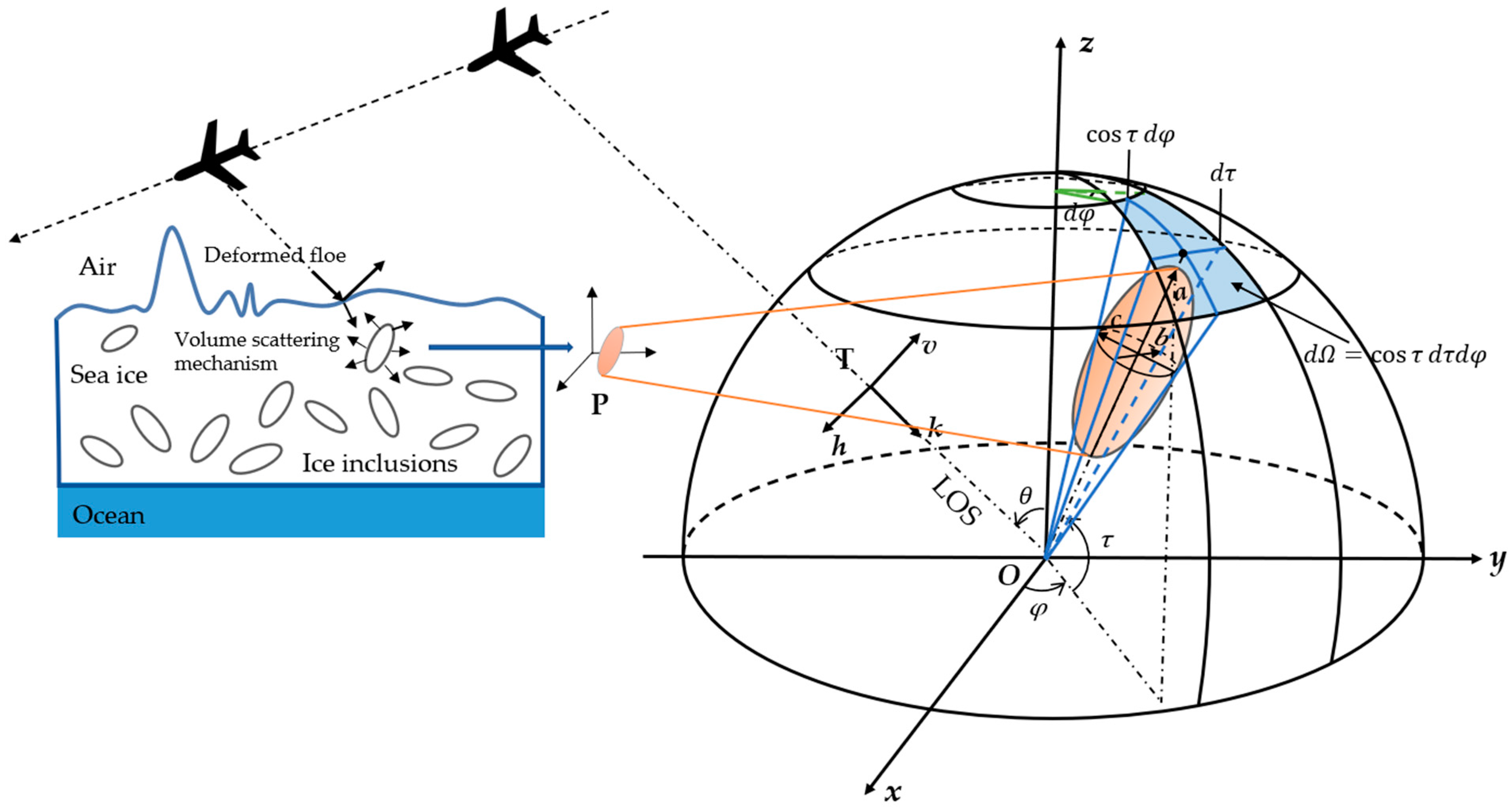
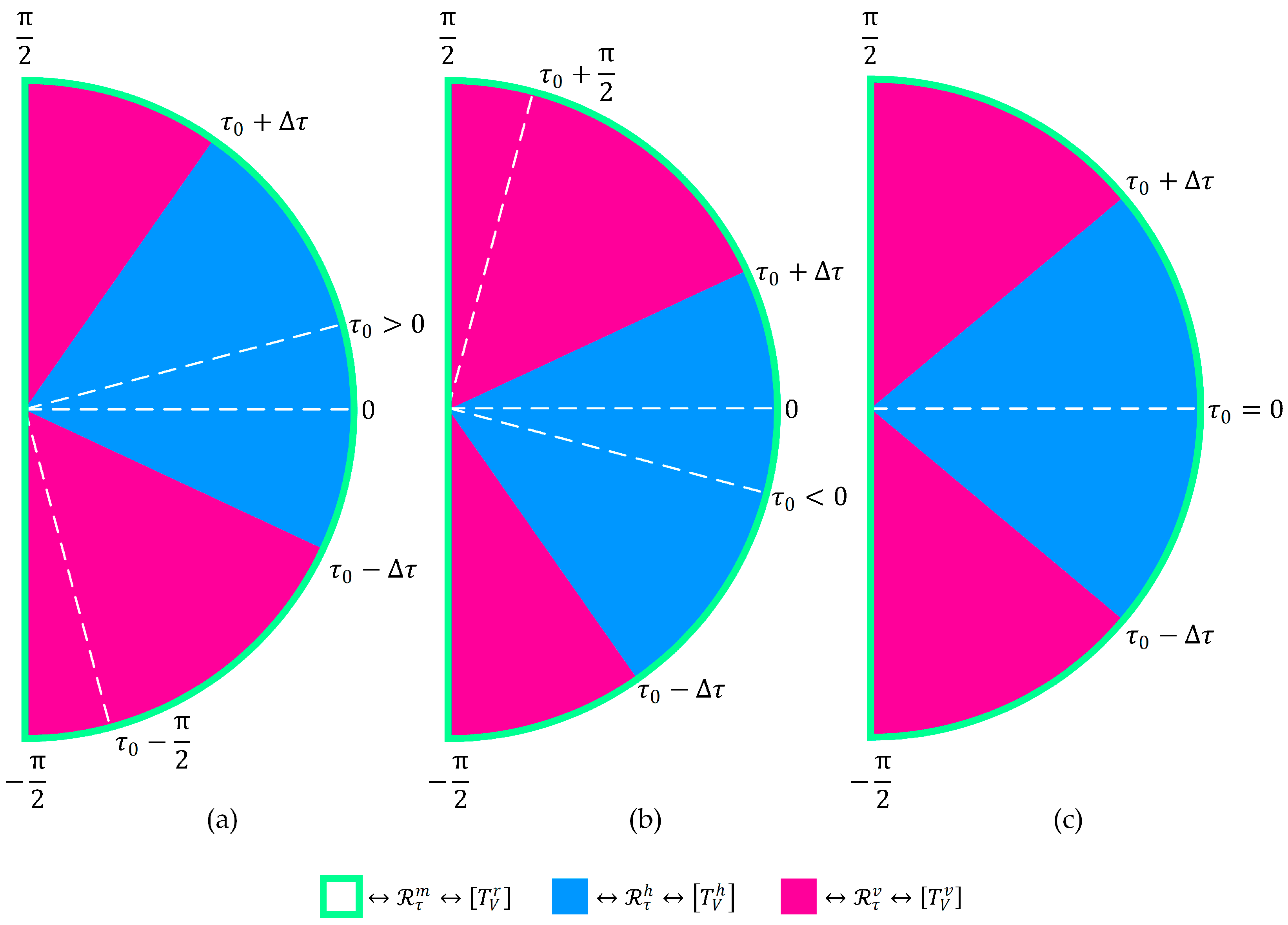
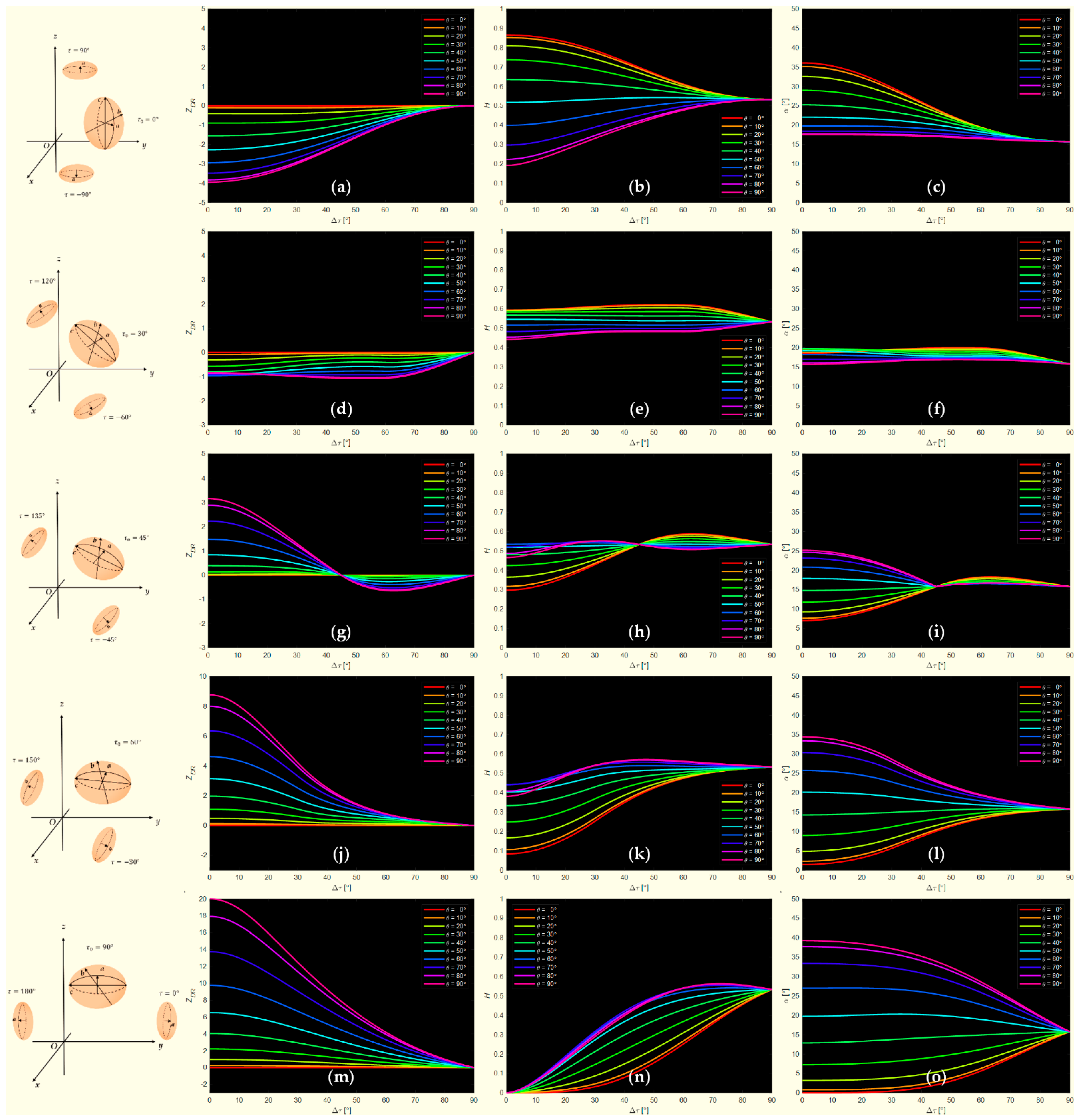
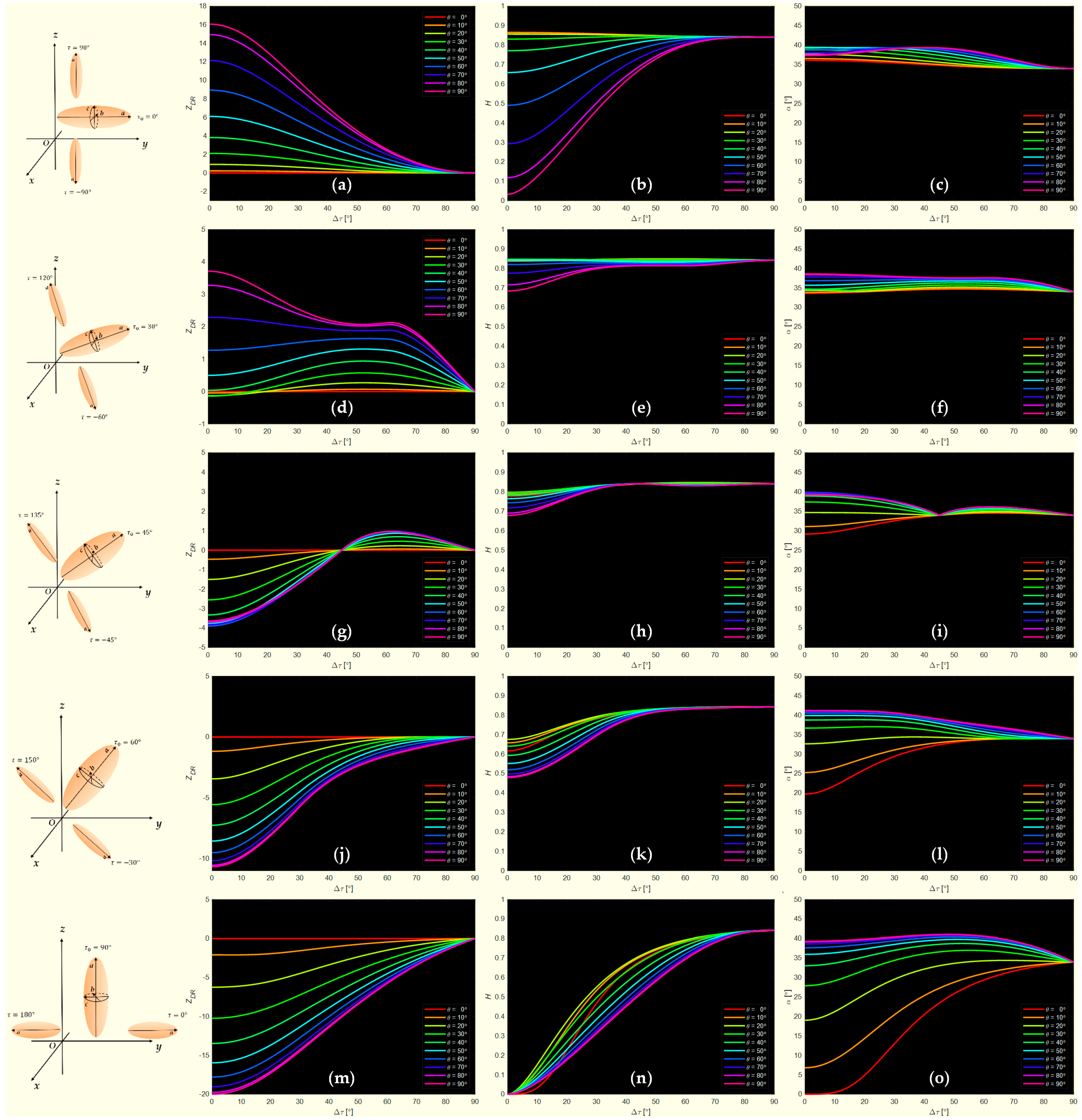

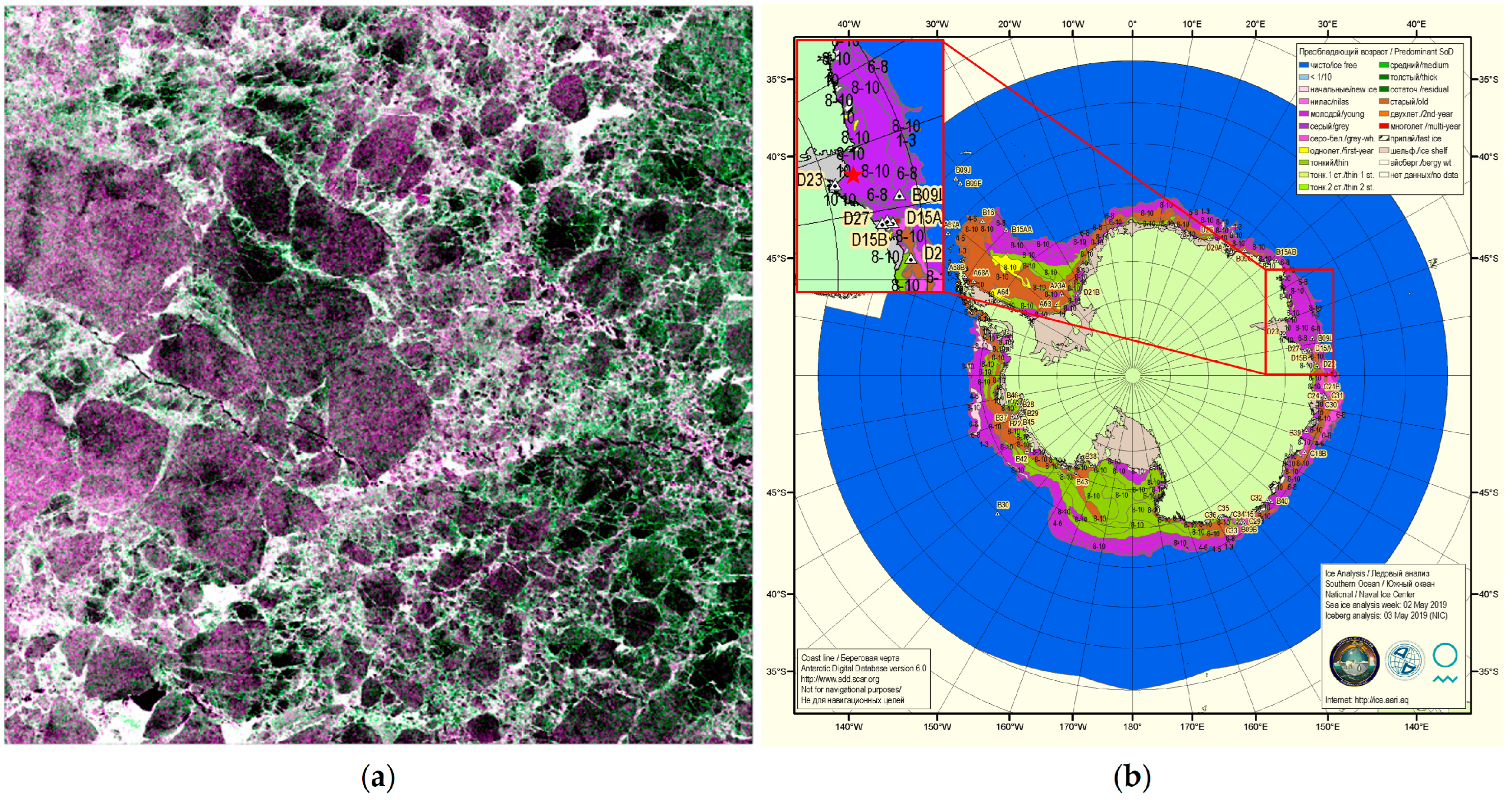
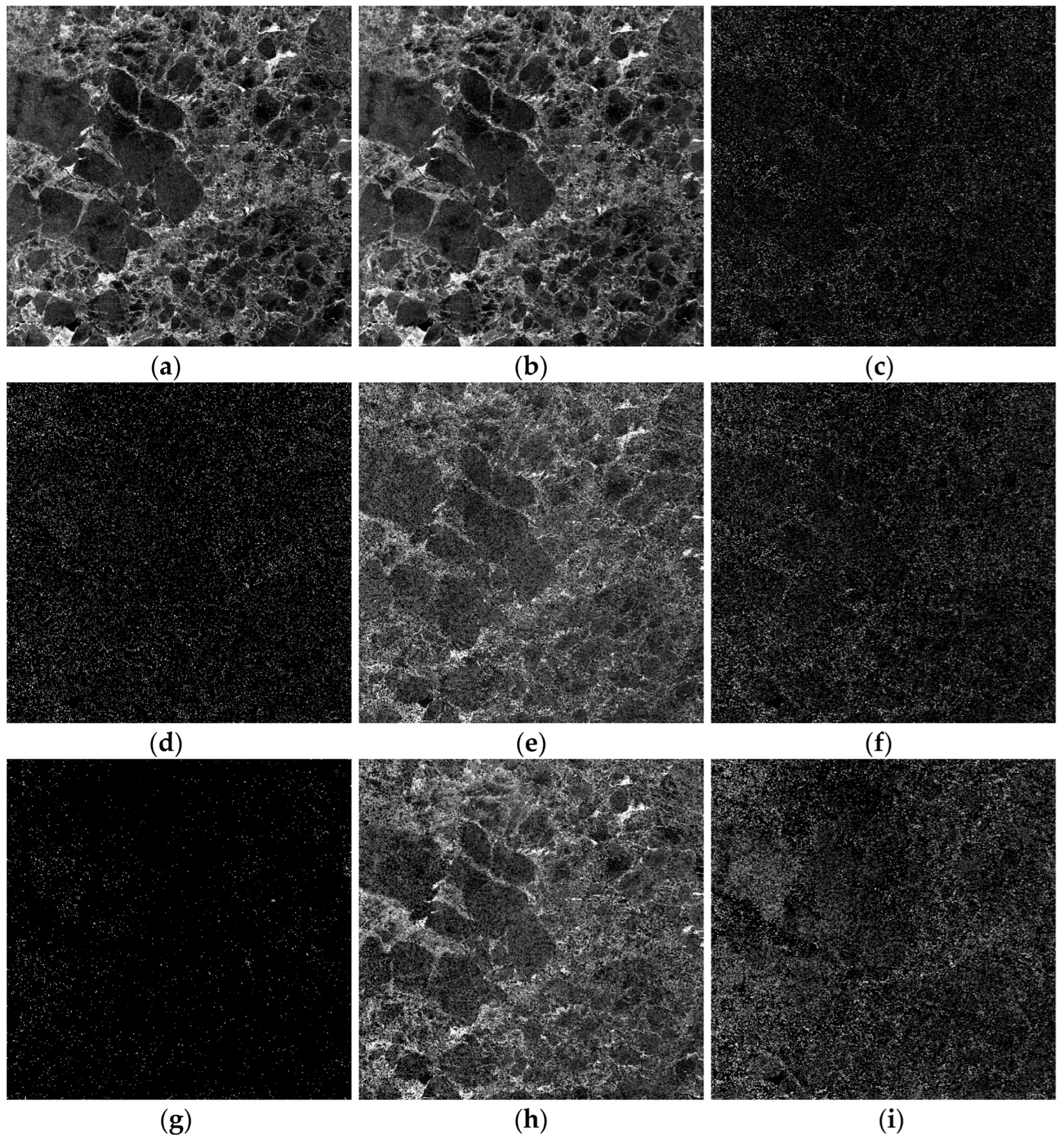

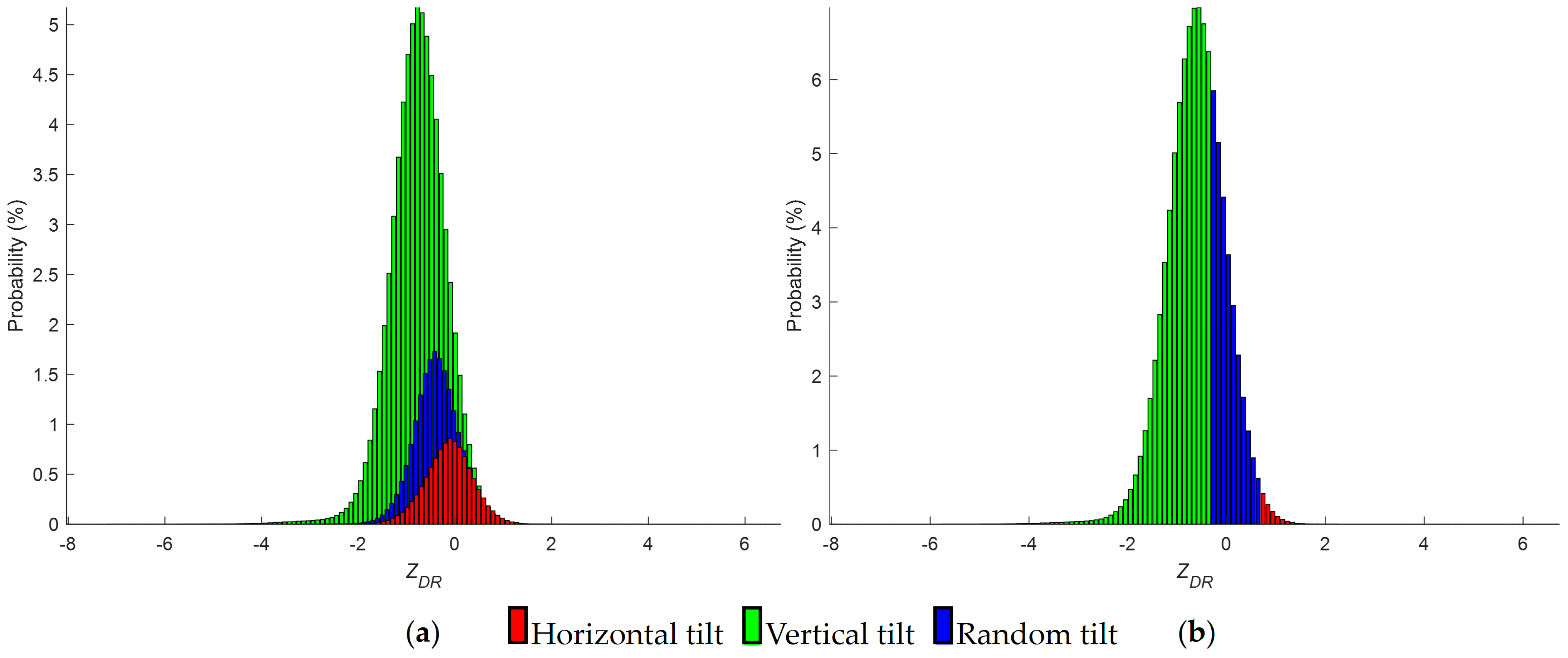
Disclaimer/Publisher’s Note: The statements, opinions and data contained in all publications are solely those of the individual author(s) and contributor(s) and not of MDPI and/or the editor(s). MDPI and/or the editor(s) disclaim responsibility for any injury to people or property resulting from any ideas, methods, instructions or products referred to in the content. |
© 2023 by the authors. Licensee MDPI, Basel, Switzerland. This article is an open access article distributed under the terms and conditions of the Creative Commons Attribution (CC BY) license (https://creativecommons.org/licenses/by/4.0/).
Share and Cite
Li, D.; Lu, H.; Zhang, Y. Solid Angle Geometry-Based Modeling of Volume Scattering with Application in the Adaptive Decomposition of GF-3 Data of Sea Ice in Antarctica. Remote Sens. 2023, 15, 3208. https://doi.org/10.3390/rs15123208
Li D, Lu H, Zhang Y. Solid Angle Geometry-Based Modeling of Volume Scattering with Application in the Adaptive Decomposition of GF-3 Data of Sea Ice in Antarctica. Remote Sensing. 2023; 15(12):3208. https://doi.org/10.3390/rs15123208
Chicago/Turabian StyleLi, Dong, He Lu, and Yunhua Zhang. 2023. "Solid Angle Geometry-Based Modeling of Volume Scattering with Application in the Adaptive Decomposition of GF-3 Data of Sea Ice in Antarctica" Remote Sensing 15, no. 12: 3208. https://doi.org/10.3390/rs15123208
APA StyleLi, D., Lu, H., & Zhang, Y. (2023). Solid Angle Geometry-Based Modeling of Volume Scattering with Application in the Adaptive Decomposition of GF-3 Data of Sea Ice in Antarctica. Remote Sensing, 15(12), 3208. https://doi.org/10.3390/rs15123208





